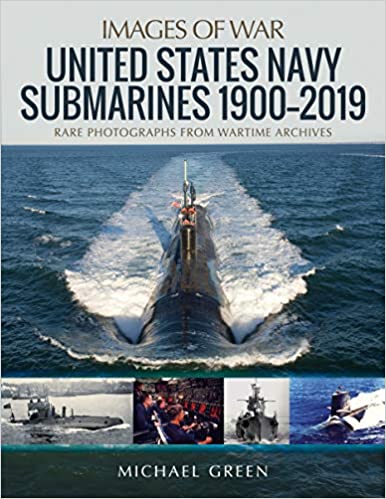
Reviewed by Jeff Schultz.
Michael Green’s United States Navy Submarines 1900-2019 provides a succinct look at the evolution of American submarines from early to modern designs, heavily supported with images, particularly wartime archival sources. It spans designs from the turn of the 20th century across the World Wars, the Cold War and the post-Cold War period all in one accessible volume.
Green divides the book into five main chapters: “The Early Years,” “Second World War,” “Cold War Diesel-Electric Submarines,” “Cold War Nuclear-Powered Submarines” and “Post-Cold War Submarines” along with a bibliography. Each chapter is amply illustrated with photographs, paintings or drawings depending on the subject at hand, well supported with an engaging text. Green has made a name for himself with a number of titles in the “Images of War” series, such as United States Marine Corps in Vietnam (2020), Aircraft Carriers of the United States Navy (2015) and Battleships of the United States Navy (2014).
Green tackles all the submarine classes from the seminal USS Holland (SS-1) to the most modern, presented in chronological order. “The Early Years” takes the reader back to 1900 and ends with the interwar designs such as the “S” and “V” classes which faced the enemy as World War II dawned. The oft ignored role of captured German technology in shaping the pre-Second World War American submarines, not only in diesel engines but also in other design features which showed up in interwar designs, is highlighted. The interwar years saw the movement away from coastal submarines to “fleet” submarines took hold. Submarines were known as “boats” or “pig boats” which had led to the modern usage of “boat” to describe a submarine.
“Second World War” gives a ringside seat to the costly conflict that propelled the United States into superpower status, with no small thanks to the submarines who brought the Pacific War to bear on Imperial Japanese shipping and accounted for slightly more than 50% of merchant ships lost. During the war five classes resulted in over 200 submarines produced: Seadragon, Tambor, Gato, Balao and Tench. Myriad Mark 14 torpedo challenges faced after Pearl Harbor are also addressed, yet even with so many difficulties American submarines proved deadly during the war. The changes which marked these wartime classes included more torpedo tubes, new submarine-delivered mines, more and improved anti-aircraft and deck armament, stronger steel strength for inner pressure hulls which allowed deeper dives, improved detection equipment and other technological advances which kept the American submariner in the ranks of the most deadly in the US Navy while also most dangerous duty by loss rate. There are also many quality images which show less understood yet vital aspects of the wartime classes such as improvements in hydrophones, sonar, radar, torpedo computers and more.
“Cold War Diesel-Electric Submarines” develops the careers of many ex-WWII submarines modified to handle the threat of the Cold War-era with emerging technology such as the German-developed Schnorkel as the use of deck guns became obsolete. With the Cold War now the dominant concern and no enemy merchant fleet to sink, American submarines adapted into radar pickets, transports and other auxiliary designs beyond upgrades and modifications to meet the new Soviet-centric reality. The GUPPY (as “Greater Underwater Propulsion Power”) program took late WWII-era boats and upgraded them owing to budgetary limits which did not favor completely new designs like the advanced German Type XXI. Also, in this era were the first submarine launched cruise missiles such as the “Loon” (a German V-1 copy) and the improved “Regulus I & II” with progressively improved means for launching them at sea.The Barbel class represented the last diesel-electric boats of the US Navy, incorporating the improved teardrop hull design of the experimental USS Albacore (AGSS-569), which served ably from 1959 to 1990.
“Cold War Nuclear-Powered Submarines” covers the parallel rise of the nuclear-powered submarine, first the USS Nautilus (SSN-571) in 1954 and then many others would follow under the tutelage of the incomparable Admiral Hyman Rickover as both attack and ballistic missile or “boomer” types. Using the newly designed powerplant allowed submarines to remain submerged much longer than before, limited only by the stores they carried. Such a seminal propulsion improvement led to the eventual rise of submarine launched ballistic missiles (SLBMs) as part of the nuclear triad. Among the classes discussed are the Thresher/Permit, Sturgeon, Los Angeles, Seawolf, and Ohio with a variety of roles such as radar picket and supporting US Navy SEALs; along with new weaponry such as the “Tomahawk” cruise missile, the “Harpoon” anti-ship missile and the Mk 48 ADCAP (Advanced Capabilities) torpedo and the Mk60 CAPTOR (Encapsulated Torpedo) mine.
“Post-Cold War Submarines” delves into the most modern designs, which demonstrate all the lessons and improvements of previous classes to provide the Virginia-class which now prowl the seas with previously unimaginable technological advances which have increased their relative capability astronomically compared to say the S-boats fielded in the 1920s or even the postwar GUPPY program boats of the 1950s. The upcoming Ohio-class replacement, the Columbia-class, is also profiled as the next generation of advanced ballistic missile submarines.
Michael Green’s United States Navy Submarines 1900-2019 provides a trove of not only the sort of images one expects from this series but also useful commentary interspersed with the visuals which will appeal to the novice as well as the old salt. Submariners will enjoy the treatment of their beloved boats alongside the general naval enthusiast who may not appreciate all the details so much as the larger concepts the book effectively explains and traces over time in a simple, coherent treatment which may spark further investigation into the exploits of the “Silent Service.”
Michael Green, Images of War: United States Navy Submarines 1900-2019, Pen and Sword Military, South Yorkshire: 2019. Retail: US $16
Reviewed by Jeff Schultz, Luzerne County Community College
Purchase your copy today: amzn.to/31K98yF

